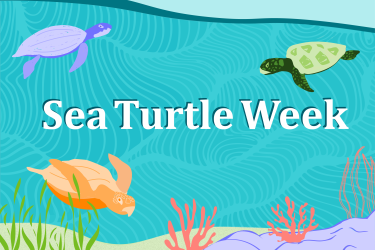Queen conch aquaculture can provide Caribbean communities with the opportunity to support and restore this unique snail species. Queen conch are vital to seagrass ecosystems and are the second largest fisheries in the Caribbean. However, due to historic overfishing, current fishing pressure, coastal storms, and habitat changes queen conch numbers have declined. To combat this decline, a partnership in Puerto Rico is working to farm conch for release into the wild and for sustainable seafood production.
“The majority of Puerto Rico’s estimated 1,200–1,500 commercial fishers are dive fishers who depend on the conch fishery as a main source of income,” said Raimundo Espinoza, Executive Director, Conservación ConCiencia. Espinoza represents one of three partners working through a NOAA Saltonstall-Kennedy Grant Program funded project to aid in the restoration of the economically and culturally important queen conch species. “Culturally, conch has deep roots in Puerto Rico dating back to the indigenous Taino who ate conch and used its shell for art, decorations, and the famous ‘Guamo’ the conch shell trumpet.”
The organizations partnering on this project include:
- Florida Atlantic University’s Harbor Branch Oceanographic Institute
- Conservación ConCiencia
- Naguabo Fishing Association
Through the grant, NOAA is supporting the renovation, installation, and operation of The Queen Conch Hatchery located in Naguabo. “The Naguabo Queen Conch Hatchery in Puerto Rico is the first of its kind in that it is located in a Fishing Association and the fishers assist with the operation of the hatchery,” said Megan Davis, Research Professor at Florida Atlantic University. This project is the first time that a conch hatchery is part of a fishing association. The fishers can diversify their income by assisting with the operation. “Fishers collect the egg mass sections from their known fishing grounds, help with installation of the facilities, and assist with the day-to-day work in the hatchery.”
Farming Queen Conch
To farm queen conch, the fishers harvest conch egg masses from the ocean, which are then placed in incubator cylinders in the hatchery. Once hatched, the free-swimming larval conch feed on phytoplankton. They live in the hatchery larval tanks for 21 days until they are ready to settle and become bottom-dwelling snails. The conch continue to develop their shell, the same one they hatched with. The juvenile conch are fed a gel-diet that includes macroalgae and are raised on sandy bottom tanks for a year before they are then transplanted out to the wild.
This restoration to the wild, sometimes called ocean ranching, allows juvenile conch to grow to marketable size and provides future harvest opportunities for island fishers. This outplanting also increases the odds of mature queen conch finding a mate to produce the next generation of conch. Conch have internal fertilization and male and female conch need to be at a density of at least 100 conch per hectare (2.2 acres) in order to find each other for mating. Too few mature conchs in the wild would impact new juvenile conch recruitment.
Working Together to Restore Conch
Along with the grant support and hatchery practices, a large portion of the restoration work and future success rests in the partnerships built across stakeholder groups in Puerto Rico. “All three partners bring complementary experiences and skills to the project,” added Davis. The lab’s hope is to deepen people’s understanding of marine life and the importance of harvesting from the ocean respectfully. “This project is built around the concept of inclusivity and collaboration which creates a welcoming space for all to learn about aquaculture, and have first-hand access to the fields of STEM,” added Hatchery Manager Victoria Cassar.
Providing accessibility and restoring an ocean-based economic opportunity allows local communities to remain working on the water while using the conch harvest skills passed down through generations. While daily operations continue under the direction of Hatchery Manager Victoria Cassar and Hatchery Assistant Marie Garcia, the partnership team is also working to educate the next generation of conch farmers. The hatchery’s latest addition to the team is local high school intern Hizdalimar "Dali" Montañez. “Beyond the specifics of aquaculture education, this project shows the potential for future careers in STEM, as well as potential entrepreneurial opportunities that have not been seen before locally,” said Cassar.
Like many other aquaculture projects, queen conch aquaculture is working towards providing sustainable seafood, improving economic opportunities in coastal communities, and increasing aquaculture literacy. As U.S. aquaculture for commercial harvest and restoration continue to grow, partnerships like the Puerto Rico, Naguabo Queen Conch Hatchery will serve as an example of the work that can be accomplished with meaningful partnerships.


